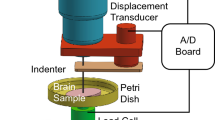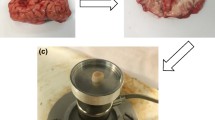Abstract
In this paper, the dynamic behavior of bovine brain tissue, measured from a set of in vitro experiments, is investigated and represented through a nonlinear viscoelastic constitutive model. The brain samples were tested by employing unconfined compression tests at three different deformation rates of 10, 100, and 1000 mm/s. The tissue exhibited a significant rate-dependent behavior with different compression speeds. Based on the parallel rheological framework approach, a nonlinear viscoelastic model that captures the key aspects of the rate dependency in large-strain behavior was introduced. The proposed model was numerically calibrated to the tissue test data from three different deformation rates. The determined material parameters provided an excellent constitutive representation of tissue response in comparison with the test results. The obtained material parameters were employed in finite element simulations of tissue under compression loadings and successfully verified by the experimental results, thus demonstrating the computational compatibility of the proposed material model. The results of this paper provide groundwork in developing a characterization framework for large-strain and rate-dependent behavior of brain tissue at moderate to high strain rates which is of the highest importance in biomechanical analysis of the traumatic brain injury.








Similar content being viewed by others
References
Anderson PS (2018) Making a point: shared mechanics underlying the diversity of biological puncture. J Exp Biol 221:jeb187294
Bergstrom JS (2015) Mechanics of solid polymers: theory and computational modeling. William Andrew, Norwich
Bergström J, Boyce M (2001) Constitutive modeling of the time-dependent and cyclic loading of elastomers and application to soft biological tissues Mechanics of materials 33:523–530
Boyce MC, Weber G, Parks DM (1989) On the kinematics of finite strain plasticity. J Mech Phys Solids 37:647–665
Budday S et al (2017) Mechanical characterization of human brain tissue. Acta Biomater 48:319–340
Dafalias Y (1986) Erratum:“The Plastic Spin” (Journal of Applied Mechanics, 1985, 52, pp. 865–871). J Appl Mech 53:290
Dalrymple T, Hurtado J, Lapczyk I, Ahmadi H (2015) Parallel rheological framework to model the amplitude dependence of the dynamic stiffness in carbon-black filled rubber. Const Models Rubber IX:189
de Rooij R, Kuhl E (2016) Constitutive modeling of brain tissue: current perspectives. Appl Mech Rev 68:010801
Donnelly B, Medige J (1997) Shear properties of human brain tissue. J Biomech Eng 119:423–432
El Sayed T, Mota A, Fraternali F, Ortiz M (2008a) Biomechanics of traumatic brain injury. Comput Methods Appl Mech Eng 197:4692–4701
El Sayed T, Mota A, Fraternali F, Ortiz M (2008b) A variational constitutive model for soft biological tissues. J Biomech 41:1458–1466
Elkin BS, Ilankovan A, Morrison B (2010) Age-dependent regional mechanical properties of the rat hippocampus and cortex. J Biomech Eng 132:011010
Eslaminejad A, Hosseini-Farid M, Ramzanpour M, Ziejewski M, Karami G (2018a) Determination of mechanical properties of human skull with modal analysis. In: ASME 2018 international mechanical engineering congress and exposition. American Society of Mechanical Engineers, pp V003T004A097–V003T004A097
Eslaminejad A, Hosseini Farid M, Ziejewski M, Karami G (2018b) Brain tissue constitutive material models and the finite element analysis of blast-induced traumatic brain injury. Sci Iran 25:3141–3150
Farahmand F, Ahmadian M (2018) A novel procedure for micromechanical characterization of white matter constituents at various strain rates. Sci Iran. https://doi.org/10.24200/sci.2018.50940.1928
Farid MH (2019) Mechanical characterization and constitutive modeling of rate-dependent viscoelastic brain tissue under high rate loadings. North Dakota State University
Farid MH, Eslaminejad A, Ziejewski M, Karami G (2017) A study on the effects of strain rates on characteristics of brain tissue. In: ASME 2017 international mechanical engineering congress and exposition, 2017. American Society of Mechanical Engineers, pp V003T004A003–V003T004A003
Farid MH, Eslaminejad A, Ramzanpour M, Ziejewski M, Karami G (2018) The strain rates of the brain and skull under dynamic Loading. In: ASME 2018 international mechanical engineering congress and exposition, 2018. American Society of Mechanical Engineers, pp V003T004A067–V003T004A067
Faul M, Xu L, Wald MM, Coronado VG (2010) Traumatic brain injury in the United States, Centers for Disease Control and Prevention, National Center for Injury Prevention and Control, Atlanta, GA
Forte AE, Gentleman SM, Dini D (2017) On the characterization of the heterogeneous mechanical response of human brain tissue. Biomech Model Mechanobiol 16:907–920
Galford JE, McElhaney JH (1970) A viscoelastic study of scalp, brain, and dura. J Biomech 3:211–221
Ghoreishy MHR, Sourki FA (2018) Development of a new combined numerical/experimental approach for the modeling of the nonlinear hyper-viscoelastic behavior of highly carbon black filled rubber compound. Polym Test 70:135–143
Giordano C, Cloots R, Van Dommelen J, Kleiven S (2014) The influence of anisotropy on brain injury prediction. J Biomech 47:1052–1059
Goriely A, Budday S, Kuhl E (2015a) Chapter two-neuromechanics: from neurons to brain. Adv Appl Mech 48:79–139
Goriely A et al (2015b) Mechanics of the brain: perspectives, challenges, and opportunities. Biomech Model Mechanobiol 14:931–965
Haldar K, Pal C (2018) Rate dependent anisotropic constitutive modeling of brain tissue undergoing large deformation. J Mech Behav Biomed Mater 81:178–194
Holbourn A (1943) Mechanics of head injuries. The Lancet 242:438–441
Hosseini-Farid M, Ramzanpour M, Eslaminejad A, Ziejewski M, Karami G (2018) Computational simulation of brain injury by golf ball impacts in adult and children. Biomed Sci Instrum 54:369–376
Hosseini-Farid M, Ramzanpour M, Ziejewski M, Karami G (2019a) A compressible hyper-viscoelastic material constitutive model for human brain tissue and the identification of its parameters. Int J Non-Linear Mech 116:147–154
Hosseini-Farid M, Rezaei A, Eslaminejad A, Ramzanpour M, Ziejewski M, Karami G (2019b) Instantaneous and equilibrium responses of the brain tissue by stress relaxation and quasi-linear viscoelasticity theory. Sci Iran 26:2047–2056
Hrapko M, van Dommelen JAW, Peters GWM, Wismans JSHM (2006) The mechanical behaviour of brain tissue: large strain response and constitutive modeling. Biorheology 43:623–636
Hrapko M, Van Dommelen J, Peters G, Wismans J (2009) On the consequences of non linear constitutive modelling of brain tissue for injury prediction with numerical head models. Int J Crashworthiness 14:245–257
Hurtado J, Lapczyk I, Govindarajan S (2013) Parallel rheological framework to model non-linear viscoelasticity, permanent set, and Mullins effect in elastomers. Const Models Rubber VIII95:95–100
Jahani B, Salimi Jazi M, Azarmi F, Croll A (2018) Effect of volume fraction of reinforcement phase on mechanical behavior of ultra-high-temperature composite consisting of iron matrix and TiB2 particulates. J Compos Mater 52:609–620
Jaishankar A, McKinley GH (2013) Power-law rheology in the bulk and at the interface: quasi-properties and fractional constitutive equations. Proc R Soc A Math Phys Eng Sci 469:20120284
Laksari K, Shafieian M, Darvish K (2012) Constitutive model for brain tissue under finite compression. J Biomech 45:642–646
Lee EH (1969) Elastic-plastic deformation at finite strains. J Appl Mech 36:1–6
Mendis KK, Stalnaker RK, Advani SH (1995) A constitutive relationship for large deformation finite element modeling of brain tissue. J Biomech Eng 117:279–285
Miller K (1999) Constitutive model of brain tissue suitable for finite element analysis of surgical procedures. J Biomech 32:531–537
Miller K, Chinzei K (1997a) Constitutive modeling of brain tissue: experiment and theory. J Biomech 30:1115–1121
Miller K, Chinzei K (1997b) Constitutive modelling of brain tissue: experiment and theory. J Biomech 30:1115–1121
Miller K, Chinzei K, Orssengo G, Bednarz P (2000) Mechanical properties of brain tissue in vivo: experiment and computer simulation. J Biomech 33:1369–1376
O’riordain K, Thomas P, Phillips J, Gilchrist M (2003) Reconstruction of real world head injury accidents resulting from falls using multibody dynamics. Clin Biomech 18:590–600
Ogden RW (1972) Large deformation isotropic elasticity–on the correlation of theory and experiment for incompressible rubberlike solids. Proc R Soc Lond A 326(1567):565–584
Ogden R (1986) Recent advances in the phenomenological theory of rubber elasticity. Rubber Chem Technol 59:361–383
Pamidi M, Advani S (1978) Nonlinear constitutive relations for human brain tissue. J Biomech Eng 100:44–48
Pervin F, Chen WW (2009) Dynamic mechanical response of bovine gray matter and white matter brain tissues under compression. J Biomech 42:731–735
Prevost TP, Balakrishnan A, Suresh S, Socrate S (2011) Biomechanics of brain tissue. Acta Biomaterialia 7:83–95
Quintavalla S, Johnson S (2004) Extension of the Bergstrom–Boyce model to high strain rates. Rubber Chem Technol 77:972–981
Ramazanian T, Müller-Lebschi JA, Chuang MY, Vaichinger AM, Fitzsimmons JS, O’Driscoll SW (2018) Effect of radiocapitellar Achilles disc arthroplasty on coronoid and capitellar contact pressures after radial head excision. J Shoulder Elbow Surg 27:1785–1791
Ramzanpour M, Eslaminejad A, Hosseini-Farid M, Ziejewski M, Karami G (2018) Comparative study of coup and contrecoup brain injury in impact induced TBI. Biomed Sci Instrum 54:76–82
Rashid B, Destrade M, Gilchrist MD (2012) Mechanical characterization of brain tissue in compression at dynamic strain rates. J Mech Behav Biomed Mater 10:23–38
Ratajczak M, Ptak M, Chybowski L, Gawdzińska K, Będziński R (2019) Material and structural modeling aspects of brain tissue deformation under dynamic loads. Materials 12:271
Raul J-S, Baumgartner D, Willinger R, Ludes B (2006) Finite element modelling of human head injuries caused by a fall. Int J Legal Med 120:212–218
Rueda MF, Gilchrist MD (2009) Comparative multibody dynamics analysis of falls from playground climbing frames. Forensic Sci Int 191:52–57
Saboori P, Walker G (2019) Brain injury and impact characteristics. Ann Biomed Eng 47(9):1982–1992
Shojaeiarani J, Hosseini-Farid M, Bajwa D (2019) Modeling and experimental verification of nonlinear behavior of cellulose nanocrystals reinforced poly (Lactic Acid) composites. Mech Mater 135:77–87
Tamura A, Hayashi S, Watanabe I, Nagayama K, Matsumoto T (2007) Mechanical characterization of brain tissue in high-rate compression. J Biomech Sci Eng 2:115–126
Tse KM, Lim SP, Tan VBC, Lee HP (2014) A review of head injury and finite element head models. Am J Eng Technol Soc 1:28–52
Viano DC, Lovsund P (1999) Biomechanics of brain and spinal-cord injury: analysis of neuropathologic and neurophysiology experiments. Traffic Inj Prev 1:35–43
Zhang L, Yang KH, King AI (2004) A proposed injury threshold for mild traumatic brain injury Transactions-American Society of Mechanical Engineers. J Biomech Eng 126:226–236
Acknowledgements
Special thanks to the Department of Animal Science Department at North Dakota State University for providing the brain tissues. The work was carried out in accordance with the IRB guidelines.
Author information
Authors and Affiliations
Corresponding author
Additional information
Publisher's Note
Springer Nature remains neutral with regard to jurisdictional claims in published maps and institutional affiliations.
Appendix
Appendix
1.1 Modeling parallel rheological framework in ABAQUS
Parallel rheological framework (PRF) is a finite-strain constitutive approach, which is referred to model nonlinear viscoelasticity, Mullins effect, and permanent set in polymers and elastomeric materials. The framework is made from the superposition of elastic or elastoplastic networks in parallel with one or multiple finite-strain viscoelastic network, N (Fig. 9). This material model has been available in ABAQUS 6.13 and later versions (ABAQUS/Standard User’s Manual, version 6.13; Providence, RI). This framework can be consisted of arbitrary number of viscoelastic networks and is able to (1) use a hyperelastic material model to specify the elastic response; (2) be combined with Mullins effect to predict material softening; (3) incorporate nonlinear kinematic hardening with multiple back stresses in the elastoplastic response; and (4) employ multiplicative split of the deformation gradient and a flow rule derived from a creep potential to specify the viscous behavior.
A variety of hyperelastic models (e.g., Mooney–Rivlin, neo-Hookean, Ogden, polynomial, Yeoh, etc.) in combination with various common creep laws (i.e., power law, strain-hardening power law, hyperbolic sine, Bergstrom–Boyce) or even with a user-defined creep model led to introduce a diverse material models for representing the complex viscoelastic behavior for materials.
1.2 Assign strain-hardening power-law model in ABAQUS
ABAQUS command Viscoelastic, Nonlinear, LAW = STRAIN was used to define the nonlinear viscoelastic model based on the strain-hardening power-law formulation. The strain-hardening power law is defined by specifying three material parameters: A, n, and m. To obtain physically reasonable behavior, A and n must be positive and −1 < m ≤ 0. In this study, the calibrated material model is implemented as the form of the ABAQUS inp-file format that is shown in the following:
**MATERIALS |
** |
*Material, name=Ogden-Strain-Law |
*Hyperelastic, Ogden |
2941., 1.58, 1.37 e−5 |
** |
*Viscoelastic, Nonlinear, NetworkId=1, SRatio=0.727, Law=strain |
0.02429, 0.5875, −0.1828 |
Rights and permissions
About this article
Cite this article
Hosseini-Farid, M., Ramzanpour, M., McLean, J. et al. Rate-dependent constitutive modeling of brain tissue. Biomech Model Mechanobiol 19, 621–632 (2020). https://doi.org/10.1007/s10237-019-01236-z
Received:
Accepted:
Published:
Issue Date:
DOI: https://doi.org/10.1007/s10237-019-01236-z





